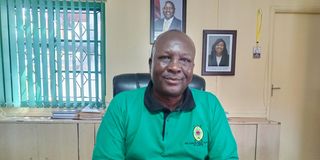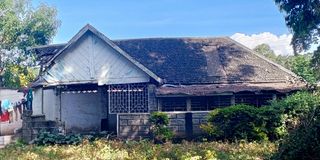Nakuru Agricultural Show: Where it all begun

Dr. Perminus Migwi, Chairman of the Nakuru Agricultural Society of Kenya (ASK) during an interview on July 1, 2024.
Growing up, many of us eagerly anticipated annual trips to the Nakuru Agricultural Show, whether with family or on school trips.
These outings were not just about having fun but also about collecting stories to share with friends who couldn't attend.
The memories, though the events were often dusty, remain vivid and cherished. The show has always been a blend of fascinating attractions.
From agricultural displays of crops and animals to the thrill of rollercoasters and the curiosity piqued by tricksters charging a small fee to see non-existent mermaids, the event has consistently offered something for everyone.
The Nakuru Agricultural Show, one of the country's pioneering agricultural showcases, was established in 1920.

One of the houses that has existed at the Nakuru ASK grounds since the colonial times.
It became the second branch of the East African Agricultural and Horticultural Society (EAA & HS), following the Nairobi branch, initiated by white settlers.
The showgrounds cover 120 acres, though many aspects have evolved over the years, including the condition of some buildings.
According to Dr. Perminus Migwi, Chairman of the Nakuru Agricultural Society of Kenya (ASK), the show initially served as a platform for white settlers to market the highlands, which were often considered uninhabitable.
Dr. Migwi explains, "Most colonialists in the Rift Valley practiced agriculture, growing tea, coffee, sisal, and pyrethrum. The show was a platform to attract more Britons to settle here."
The show's primary objective was to promote agricultural development based on European settlement.
It was the brainchild of John Ainsworth, the Sub-Commissioner for Ukambani Province. After independence, the Society was renamed the Agricultural Society of Kenya, and Kenyan chairpersons began managing the show.
The Nakuru show has had over 20 chairpersons since it began.

Some of the chairpersons who have led the Nakuru ASK showgrounds.
To diversify, the event incorporated a trade fair aspect, attracting businesses and companies beyond just agricultural exhibits.
The Nakuru Show has also been hosting annual ploughing contests at Ngongongeri Farm in Njoro to provide a comprehensive impact on farmers.
Despite interruptions during the COVID-19 pandemic, the show has maintained its annual schedule.
Looking ahead, Dr. Migwi emphasizes plans to enhance the facilities to accommodate various exhibitions, including motor and organizational exhibitions, to increase revenue.
"The improvement will help in having different exhibitions throughout the year to avoid over-reliance on the annual event," he notes.

